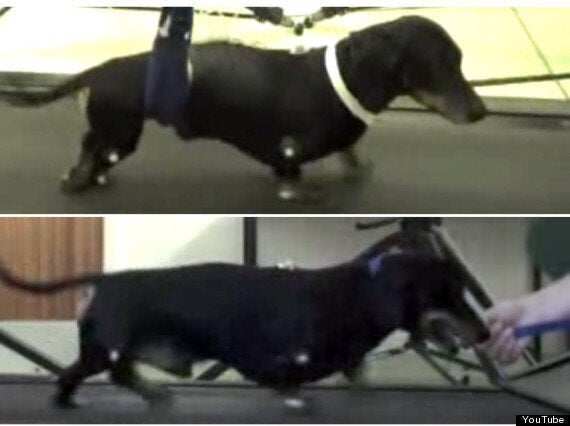A paralysed dachshund has learned to walk again after cells taken from his nose were used to bridge the breaks in his spinal cord.
Jasper, who has been unable to walk since 2008, has now been described as his owner as “whizzing around the house”.
The study offers new hope for paralysed human beings and is the first demonstration of effective spinal cord repair in “real life” injury cases.

Jasper in action - four years after he was paralysed
Professor Robin Franklin, one of the study leaders from Cambridge University, said: "Our findings are extremely exciting because they show for the first time that transplanting these types of cell into a severely damaged spinal cord can bring about significant improvement."
For more than a decade, experts have known that olfactory ensheathing cells (OECs) might prove useful in treating damaged spinal cords.
The cells support nerve fibre growth that maintains a communication pathway between the nose and the brain.
Previous research suggests that OECs can help form a bridge between damaged and undamaged spinal cord tissue by regenerating nerve fibres.
Although the treatment had been shown to be safe in human patients, its effectiveness was unknown.
In the new trial, scientists studied 34 pet dogs that had all suffered spinal cord injuries as a result of accidents and back problems. None were injured deliberately for the sake of research.
A year or more after their injuries, the animals were unable to use their back legs to walk and incapable of feeling pain in their hindquarters.
Many of the dogs were dachshunds, which are especially prone to this type of injury. Unlike humans, dogs can suffer serious damage to their spinal cord just by having a slipped disc.
One group of dogs had OECs taken from the lining of their own noses and injected into the injury site. Another was only injected with the liquid in which the cells were suspended.
The trial was "double blind", meaning that until the study ended neither the researchers nor the dog owners knew which animals had received the active treatment.
Dogs were tested for neurological function at one month intervals and had their walking ability assessed on a treadmill.
Significant improvement was seen in the dogs injected with OECs, but not those receiving the placebo treatment, according to the findings reported in the journal Brain.
OEC-treated dogs moved previously paralysed hind limbs and co-ordinated the movement with that of their front legs.
However, the researchers found that new nerve connections were only generated over short distances within the spinal cord.
Prof Franklin warned patients and their loved ones not to expect too much from the approach.
"We're confident that the technique might be able to restore at least a small amount of movement in human patients with spinal cord injuries, but that's a long way from saying they might be able to regain all lost function," he said. "It's more likely that this procedure might one day be used as part of a combination of treatments, alongside drug and physical therapies, for example."
The scientists stress that many spinal injury patients rate a return to sexual function and continence as a higher prize than improved mobility.
Some of the dogs in the trial did regain bowel and bladder control, but the number was not statistically significant.
Dr Rob Huckle, head of regenerative medicine at the Medical Research Council, which funded the study, said: "This proof of concept study on pet dogs with the type of injury sustained by human spinal patients is tremendously important and an excellent basis for further research in an area where options for treatment are extremely limited.
"It's a great example of collaboration between veterinary and regenerative medicine researchers that has had an excellent outcome for the pet participants and potentially for human patients."
Jasper's owner Mrs May Hay, from Cambridge, said: "Before the trial, Jasper was unable to walk at all. When we took him out we used a sling for his back legs so that he could exercise the front ones. It was heartbreaking. But now we can't stop him whizzing round the house and he can even keep up with the two other dogs we own. It's utterly magic."
Professor Geoffrey Raisman, chair of neural regeneration at University College London, said: "This is not a cure for spinal cord injury in humans - that could still be a long way off. But this is the most encouraging advance for some years and is a significant step on the road towards it.
"This innovative process uses olfactory ensheathing cells taken from the dog's own nasal lining. Their purpose is specialised for the repair of nerve fibres in the nose, and by transplanting them to the spinal cord they can do the same repair work there.
"This shows convincingly that the beneficial effects previously reported in rodents can be produced in other species.
"That is encouraging for application in human injuries. But from a clinical perspective, the benefits are still limited at this stage. This procedure has enabled an injured dog to step with its hind legs, but the much harder range of higher functions lost in spinal cord injury - hand function, bladder function, temperature regulation, for example - are yet more complicated and still a long way away."